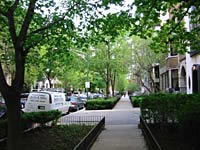The pattern of how we build our neighborhoods, towns, and cities has a tremendous impact on our natural environment.
How we design and build individual buildings also has a tremendous impact on the environment. In the United States, buildings account for over a third of our total energy use. And buildings consume nearly a third of the total raw materials, by weight, used in our economy.
At Green Street's Glenwood Park project, the majority of single-family homes, and all townhouses and condominiums are certified under the Earthcraft House (TM) program, which ensures environmental best practices.
Storm water management is another area where Glenwood Park excels. Storm water is infiltrated on a lot by lot basis and in parking lots throughout the neighborhood. Much of the water that does not infiltrate on a lot by lot basis flows to a lowland area in the main park, where it then has another opportunity to infiltrate and to be cleaned.
Street trees are an important element of the Glenwood Park environmental plan, both for bringing nature into and through the neighborhood, and also for providing shade and reducing the urban heat island effect. Over 800 trees will have been planted at Glenwood Park by the project's completion.
References:
The US Green Building Council
The Southface Energy Institute |
|

Tree-lined street in a Chicago neighborhood |